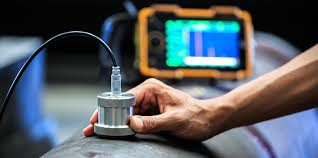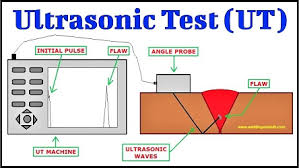Ultrasonic Testing of Castings for Internal Defects: Methods and Benefits
2024-11-22 13:52:21 hits:0

Castings are widely used in industrial manufacturing, from automotive components to aerospace structures. However, casting processes may result in internal defects such as porosity, cracks, or inclusions. If left undetected, these defects can cause component failure, leading to severe consequences. To ensure casting quality, Ultrasonic Testing (UT) has become a crucial non-destructive testing (NDT) method.
In this blog, we’ll explore the principles, application methods, and benefits of ultrasonic testing in inspecting castings.
What is Ultrasonic Testing?
Ultrasonic testing is a non-destructive testing method that uses high-frequency sound waves to evaluate the internal structure of materials. When sound waves pass through a material and encounter a defect (e.g., voids, cracks, or discontinuities), they reflect or attenuate. These reflected waves are captured and converted into visual signals for analyzing the internal conditions of the material.

Basic Principles:
- Emission of Ultrasonic Waves: A probe transmits high-frequency sound waves into the casting.
- Wave Propagation: Sound waves travel through the material at a consistent speed and reflect when encountering defects.
- Signal Analysis: By analyzing the time and intensity of the reflected waves, the location, size, and shape of defects can be determined.

Advantages of Ultrasonic Testing
- Non-Destructive:Does not compromise the integrity of the casting, making it ideal for finished products and in-process monitoring.
- High Sensitivity:Capable of detecting very small defects with high accuracy.
- Strong Penetration:Ultrasonic waves can penetrate thick casting materials and detect deep-seated defects.
- High Efficiency:Fast testing speed, suitable for mass production quality control
- Cost-Effective:Compared to destructive testing, ultrasonic testing is less costly and conserves material.
- Portability:Modern ultrasonic equipment is often portable, making it suitable for on-site inspections.
Applications of Ultrasonic Testing in Castings
Detecting Internal Defects:
- Common defects include porosity, shrinkage, cracks, inclusions, and delamination.
- Particularly effective for thick-walled castings or parts with complex geometries.
Quality Control:
- Ultrasonic testing during production can quickly identify issues, preventing defective products from reaching the market.
Lifespan Prediction:
- Regular ultrasonic testing can assess a casting's remaining life and identify potential safety risks.
Testing Objects:
- Includes various iron, steel, and aluminum alloy castings.

Challenges of Ultrasonic Testing
- Requires Skilled Operators:Proficient technicians are needed to analyze complex signals and avoid misinterpretations.
- Surface Smoothness Requirements:Castings need a smooth surface, as rough surfaces can affect coupling and signal quality.
- Material Limitations:Ultrasonic testing may perform less effectively in materials with high sound absorption or coarse grains, such as cast iron.
- Complex Geometries:Testing curved or irregular shapes may require specialized probes and techniques.
How to Improve Ultrasonic Testing Effectiveness?
Choose the Right Frequency:
Different materials and defect sizes require different sound wave frequencies. Higher frequencies are suitable for small defects, while lower frequencies are better for thick materials.
Optimize Probe Selection:
Use appropriate straight-beam, angle-beam, or phased-array probes based on the casting’s shape and material.
Surface Preparation:
Machining or polishing the casting surface can improve smoothness and enhance signal quality.
Leverage Advanced Technology:
Incorporate phased-array ultrasonic testing (PAUT) or full-matrix capture (FMC) technology to increase accuracy and efficiency.

Ultrasonic testing is a highly effective and reliable non-destructive testing method that plays a crucial role in casting quality control. It not only detects potential internal defects in castings but also reduces scrap rates during production and improves overall product quality.
With advancements in technology, such as phased-array ultrasonics and automated testing systems, the accuracy and scope of ultrasonic testing will continue to expand. For manufacturers, mastering and optimizing this technology is an essential step toward enhancing product competitiveness.
Whether you’re a producer or an end-user, ultrasonic testing provides a robust guarantee of casting quality, ensuring safer and more efficient industrial manufacturing.

 en
en  fra
fra  de
de  ru
ru  gle
gle  th
th  ara
ara  it
it  jp
jp  kor
kor  zh
zh 


